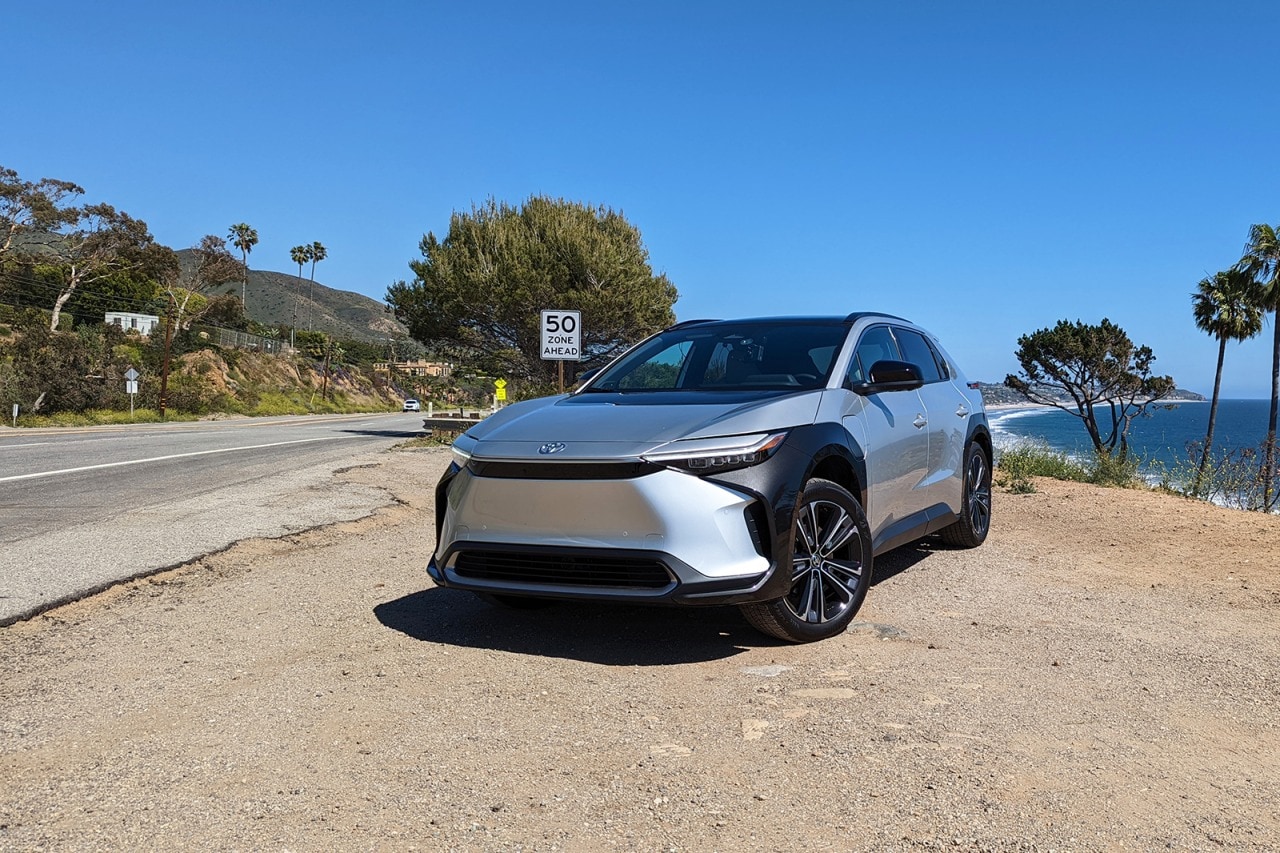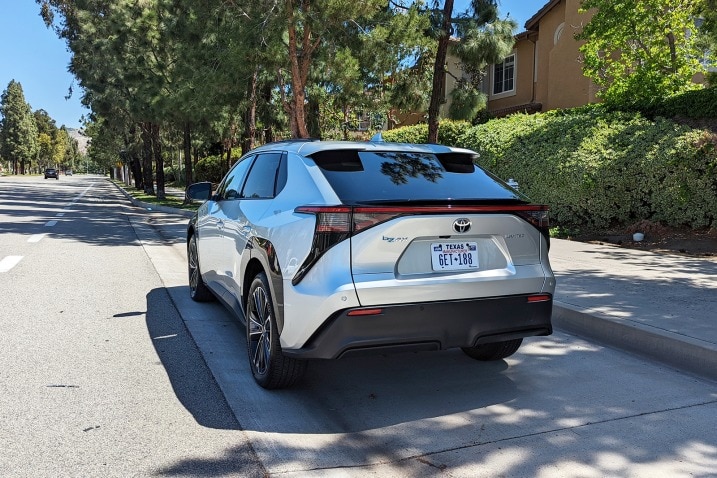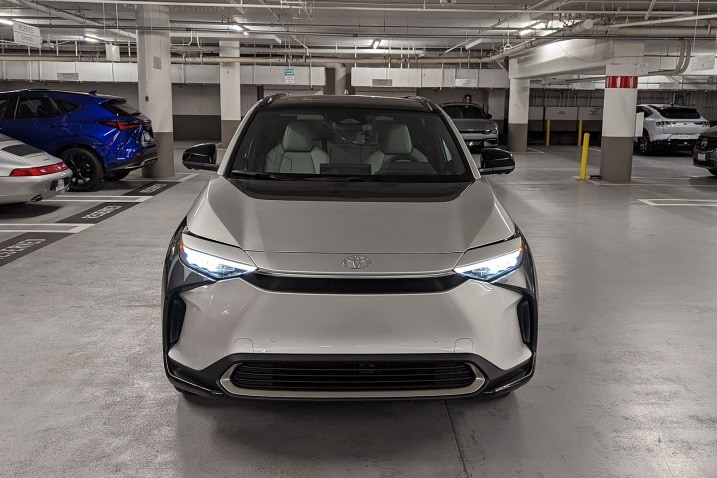- The single-motor 2023 Toyota bZ4X Limited FWD covered 227 miles in Edmunds' real-world EV range test, missing its EPA-estimated range by 15 miles.
- The bZ4X also consumed slightly more electricity than estimated.
- The bZ4x charges at a 6.6-kilowatt rate, while many competitors support faster charging up to 11 kW.
TESTED: 2023 Toyota bZ4X Falls Short of EPA Range Estimate
Late to the party, brought fruitcake
Toyota's first mass-market EV, the 2023 bZ4X, has finally arrived, and we're frankly not very impressed. We're not trying to say that EVs are an easy formula to get right, especially when you're trying to balance quality, capability and cost. But Toyota was dipping its toes in the EV pond before Tesla even existed, so it's surprising that the bZ4X doesn't have more points in its favor.
Quick trip down memory lane: In 1997 Toyota produced an electric version of the first-generation RAV4, albeit in highly limited quantities, and then followed up with the second-generation RAV4 EV in 2012. Let's not forget about Toyota's first- and second-generation Mirai fuel cell electric vehicles too. This isn't Toyota's first rodeo, in other words. But we're not exactly seeing signs of veteran experience in the bZ4X.
The development of the bZ4X was a joint effort between Toyota and Subaru, which markets its version as the Solterra. While the Subaru comes only with dual-motor all-wheel drive, the bZ4X also offers single-motor front-wheel drive, which explains why its EPA range estimates go as high as 252 miles (in XLE FWD trim). We tested the Limited FWD trim, which carries a range estimate of 242 miles, the second-longest in the bZ4X lineup.
Toyota isn't making any headlines, good or bad, with a projected range of 242 miles. But as we've seen, range can vary greatly once you're driving on real roads, so we wanted to see how the new electric Toyota would fare on Edmunds' real-world EV loop. Here's how it did.
Am I Ready for an EV?
- EV ownership works best if you can charge at home (240V outlet) This typically means a 240V home installation, or other places your car is parked for several hours each day. Don't expect a regular household outlet (120V) to suffice.
- Adding a home charging system is estimated to cost $1,616 in This is an estimate for your area. Using your address and the answers you provide, Treehouse can provide a more accurate price.
- Edmunds is partnering with Treehouse, an independent provider of home EV installation services. Learn more Edmunds customers receive a 10% installation discount and 4% smart charger discount. Discount excludes permit, hosted inspection, and load management devices. Valid for 30 days.
Testing the bZ4X in the real world
Edmunds tests every new electric vehicle on the same real-world driving loop to see just how far it can travel from a full charge down to zero miles remaining. If you scroll through our EV range leaderboard, you'll see that most EVs have matched or exceeded their EPA range estimates in our testing. Much of that has to do with our ability to test in near ideal conditions year-round.
The bZ4X is offered with either a single motor driving the front wheels (201 horsepower, 196 lb-ft of torque) or dual motors driving all four wheels (214 hp, 248 lb-ft). If you're wondering, yes, that's a surprisingly small output bump with the second motor. Either powertrain can be had in the base XLE or top Limited trim, which means the bZ4x comes in a total of four configurations, each with its own range and efficiency estimates.
Our test car was the single-motor bZ4X Limited with its upsized 20-inch wheels, which came wrapped in all-season tires (Bridgestone Turanza EL450 235/50R20 100V) inflated to the factory-recommended 38 psi all around. Opt for the standard XLE and you'll get 18-inch wheels, which save about 130 pounds at the scales and of course put less rubber on the road, accounting for the XLE's 10-mile range advantage. There are a few packages and accessories available, but the trims for the most part dictate how your car is equipped. Our Limited trim car didn't have any extra options and weighed in at 4,276 pounds on our scales. This is significantly lighter than Toyota's official number for a FWD Limited (4,398 pounds) and only 10 pounds more than the automaker says the FWD XLE should weigh.
After a full day of driving at an average temperature of 65 degrees, which is pretty mild weather, the single-motor bZ4X Limited FWD only managed to go 227 miles. This falls short of its EPA range estimate by 15 miles or 6.2%, which is rare for this class of EVs. The only other non-luxury EV to fall short in our testing was the Tesla Model 3 Standard Range Plus.
So how much did those 227 miles cost?
While the total range of a vehicle continues to dominate the EV conversation, energy consumption is an important factor as well. Energy consumption is what determines how much your miles will cost you. The unit of measurement for consumption, the kilowatt-hour, can be thought of as the EV equivalent of a gallon of gasoline. Just like gas, the price of electricity varies depending on where you live. For example, you'll pay about 10 cents per kWh in North Dakota as of this writing, whereas in Hawaii it'll run you about 40 cents.
So, what can Toyota owners expect to pay at "the pump"? After charging its battery pack back to full, we calculated an Edmunds consumption rate of 28.5 kWh/100 miles. Compared to its EPA consumption estimate of 26 kWh/100 miles, our bZ4X was less efficient by 9.6%. It's worth noting that the bZ4X's maximum Level 2 charging rate is 6.6 kW, which is slower than competitors like the Ford Mustang Mach-E and Volkswagen ID.4, both of which support charging at rates up to 11 kW. If we lived in Hawaii, our 227-mile trip in the bZ4X would have cost us $25.88, while if we lived in North Dakota, that same trip would cost just $6.47.
Even though the base Model 3 didn't hit its range either, it still stands as one of the most efficient EVs on the road. The one we tested back in 2020 used only 23 kWh to go 100 miles. In the most expensive state for electricity (Hawaii), if we assume 5,000 miles of driving a year, which could be possible on an island, you'd probably save a little over a hundred dollars a year driving the Tesla instead of the Toyota.
How about a gasoline-powered equivalent? Someone considering the bZ4X may have looked at or maybe even own a Toyota RAV4. They are similar in size and accommodations and the RAV4's 2.5-liter inline four-cylinder engine even makes similar power (203 hp) and torque (184 lb-ft) to the single-motor bZ4X. The RAV4 also runs on regular fuel, which helps take some of the sting out of filling up that 14.5-gallon tank. The RAV4 is estimated to return a respectable 30 mpg in combined driving. Assuming we got the combined mpg, driving it for 227 miles would have set us back $41.16 in Hawaii ($5.44 per gallon) and $32.61 in North Dakota ($4.31 per gallon) at current prices, which is surprisingly decent considering gas prices today.
Based on these numbers, your estimated fuel savings per year would be around $673 in Hawaii and $1,152 per year in North Dakota by driving a bZ4X for 10,000 miles instead of a RAV4. But from a price perspective, the RAV4 Limited (FWD) undercuts the bZ4X Limited by roughly $11K before factoring in the $7,500 federal tax credit for EVs. If you are able to take full advantage of the EV tax credit, you'd make up the cost difference of the bZ4X in a little over three years if you call yourself a North Dakotan. It'll be more like 10-plus years if you're a Hawaiian, because y'all know surfing is more important than driving.
For more information on how we test EV range and how each vehicle performed, we invite you to visit our Real World vs. EPA testing page, which includes both our EV range leaderboard and a table with detailed test results. Our EV range leaderboard is embeddable and will automatically update every time we add a new vehicle.
Edmunds says
The 2023 Toyota bZ4X comes up a bit short in many areas, but we weren't expecting range to be one of them. Despite that, it's likely the bZ4X will convince some of the Toyota faithful that it's time to give EVs a try. We're not ruling out the possibility of our specific test car having an isolated issue, so we're looking forward to testing other variations of the bZ4X to see if the results are consistent. We've tested enough Teslas to draw some conclusions there, and we're hoping it's a different story with Toyota. For our latest comprehensive ratings of all electric vehicles, head over to Edmunds' EV rankings page.







 by
by